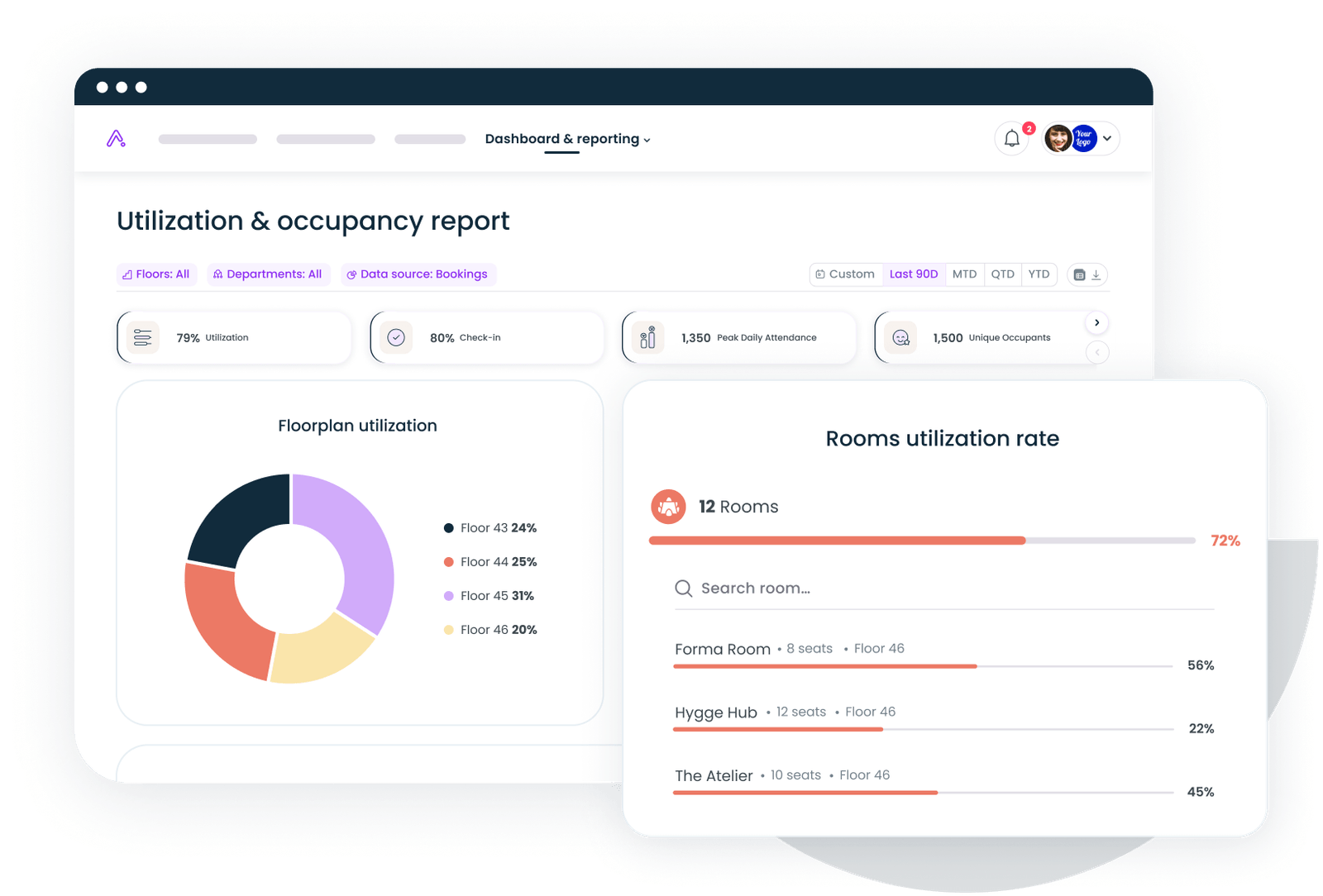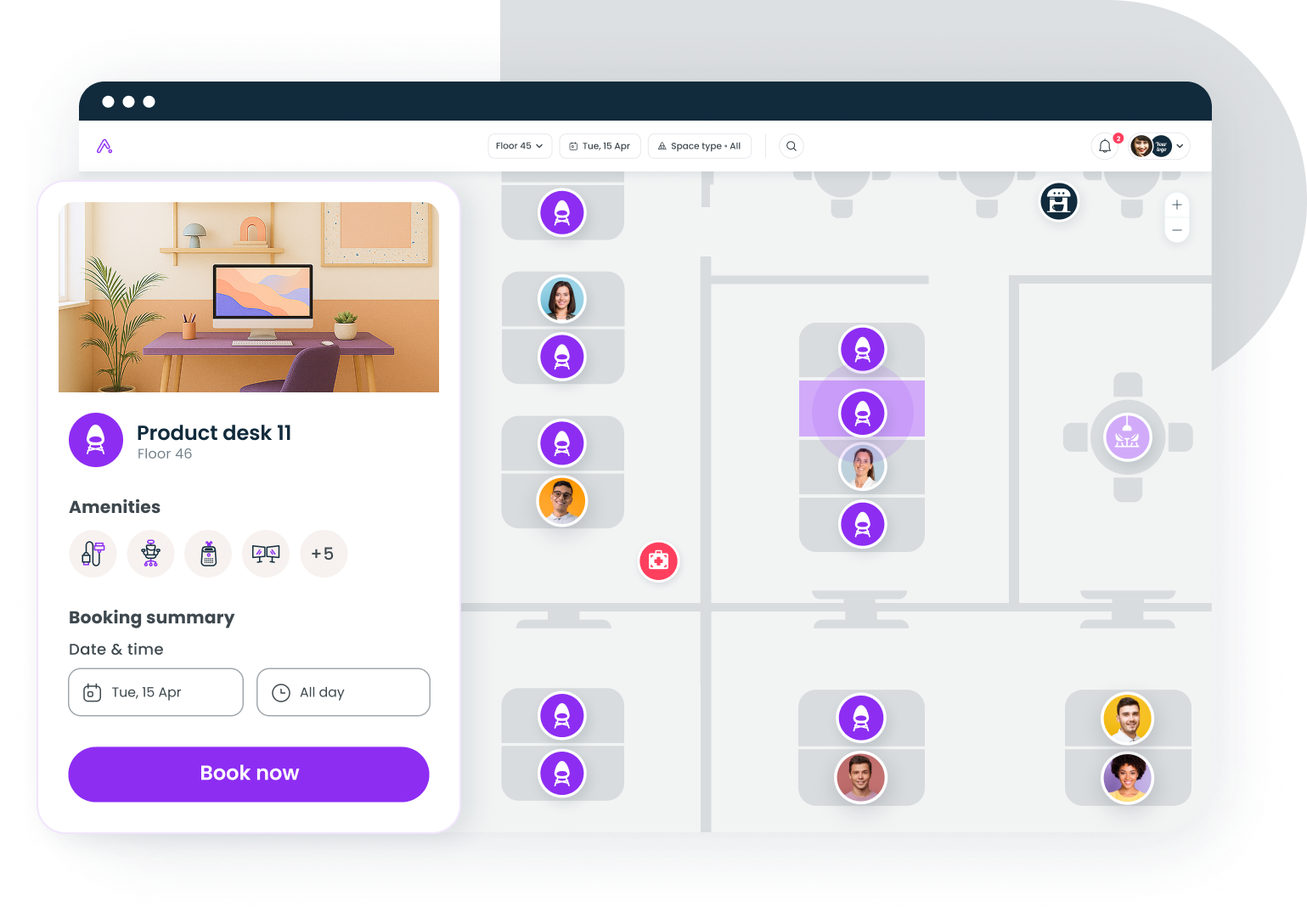Your team is working harder than ever, yet projects still miss deadlines. Meeting rooms sit empty while employees struggle to find collaboration space. Administrative tasks eat up hours that could drive innovation.
Research shows the average worker is productive for just over four hours per day, yet workplace efficiency remains one of the most overlooked opportunities for organizational success. The difference between struggling companies and productive companies isn't about working more hours—it's about creating an efficient workplace where every resource delivers maximum results.
This guide covers everything workplace leaders need to know: what workplace efficiency means, how to measure it accurately, and practical strategies to improve efficiency without burning out your team.
What is workplace efficiency?
Workplace efficiency is achieving maximum results while minimizing wasted time, effort, and resources. Productivity tells you how much work gets completed, while efficiency reveals how well you're using your resources to complete that work. An efficient workplace produces high-quality output without unnecessary steps, eliminating waste while maintaining standards.
Here's what sets efficient workplaces apart:
Clear communication flows freely. Teams understand expectations, goals align across departments, and information moves without bottlenecks. When everyone knows what needs to happen, wasted time disappears.
Processes are streamlined. Complex processes get simplified, unnecessary approval layers vanish, and teams can focus on work that matters rather than navigating administrative tasks that hinder progress.
Resources are optimized. From employee skills to digital tools, everything gets deployed where it creates the most value. Companies that match employee performance to the right roles see significant boost in both productivity and employee satisfaction.
Work environments support focus. The physical and digital work environment enables progress. Employees can minimize distractions and stay focused on completed tasks.
Why measuring workplace efficiency matters
You can't improve what you don't measure. Without tracking efficiency, you're making workplace decisions based on assumptions rather than data—and that's expensive.
Research by McKinsey reveals that boosting productivity represents a $10 trillion opportunity for organizations. According to Gallup, global employee engagement declined to 21% in 2024, with lost productivity costing the global economy $438 billion.
Measuring efficiency reveals where time gets lost, which processes create bottlenecks, and how employee hours translate into organizational success. It shows where resources go, what's actually working, and when burnout risks emerge. Top companies measure efficiency not to micromanage but to remove friction and make informed decisions about workforce planning, technology investments, and workspace design.
Benefits of an efficient workplace
Creating an efficient workplace delivers tangible advantages that extend far beyond checking off items on a to do list faster.
Cost savings and financial performance
Efficient processes directly impact your bottom line. Employers adopting hybrid work models are saving approximately 50% on office space and traditional real estate costs through reduced in-person attendance and more flexible office layouts. Research shows productive companies have 30-50% higher operating margins than lower-performing counterparts. This performance gap stems from efficient companies achieving maximum results without proportionally increasing costs.
Enhanced employee satisfaction and productivity levels
When you remove obstacles and eliminate waste from workflows, employees can focus on meaningful work. Hybrid workers experience 15% less burnout than full-time in-office colleagues, indicating improved well-being and more effective teamwork.
When employees are highly engaged, productivity increases by 23%, driving greater efficiency and results for organizations. This productivity boost comes from removing barriers that slow progress and creating efficient processes that support focused work.
Competitive advantage
Organizations that operate efficiently can respond faster to market changes and serve customers better. Efficiency frees up employee skills and available resources for strategic initiatives. When your team isn't buried in unnecessary steps and urgent tasks that shouldn't be urgent, they can focus on the project management and creative problem-solving that drives organizational success.

See exactly how your office performs with real-time insights into desk and room bookings, peak usage times, and space efficiency patterns.
Read more
How to calculate workplace efficiency
Before implementing improvement strategies, you need accurate baseline measurements. Here's how to calculate efficiency using reliable formulas that workplace efficiency experts recommend:
Basic productivity formula
Start with the fundamental calculation:
Productivity = Output / Input
For example, if your content team produces 10,000 words (output) in 40 employee hours (input), productivity equals 250 words per hour. This baseline allows tracking improvements over time.
However, this basic formula only measures total output—it doesn't account for quality, complexity, or resource utilization. That's where efficiency calculations become more valuable.
Calculating the efficiency score
To measure efficiency rather than just productivity:
Efficiency = (Actual productive time / Total time available) × 100
Example: An employee works an 8-hour shift but spends 2 hours on non-productive tasks like excessive phone calls or navigating administrative tasks.
8 hours scheduled - 2 unproductive hours = 6 hours of productive time (6 / 8) × 100 = 75% efficiency
This reveals that while the employee is present for 8 hours, they're only working efficiently for 75% of that time. Understanding this gap helps you identify areas where streamlining processes or providing better digital tools could boost efficiency.
Task completion rate
This metric measures workflow effectiveness:
Task Completion Rate = (Completed tasks / Assigned tasks) × 100
Track this for individuals, teams, or departments to identify bottlenecks in your processes. Consistently low completion rates signal that workloads are unrealistic, unnecessary steps slow progress, or unclear expectations create confusion.
Revenue per employee
For a high-level efficiency indicator:
Revenue Per Employee = Total Revenue / Number of Employees
This metric ties efficiency improvements directly to business results. As you streamline operations and improve efficiency, you should see this number increase without proportionally growing headcount.
Time spent vs. hours worked analysis
Understanding how employee hours actually get used reveals efficiency opportunities:
Track time spent on:
- Core work (directly contributes to output)
- Necessary support work (enables core work)
- Administrative overhead (necessary but minimal)
- Wasted time (unnecessary meetings, unclear processes)
Many factors affect how hours worked translate into meaningful output. By analyzing this breakdown, you identify where improving processes or providing better tools would have the biggest impact.
The key to measuring efficiency isn't perfection—it's consistency. Pick the metrics most relevant to your organization, track them regularly, and use the data to make informed decisions about where to focus improvement efforts.
Strategies to improve workplace efficiency
Now that you understand what workplace efficiency means and how to measure it, let's explore practical strategies you can implement to boost efficiency in your organization.
Streamline processes and eliminate unnecessary steps
Start by auditing your existing workflows. Document every step in key processes, then ask: does each step add real value? Complex processes often accumulate over time as temporary fixes become permanent fixtures.
Look for:
- Approval layers that slow decisions without improving quality
- Duplicate data entry across systems
- Meetings that could be emails
- Reports nobody actually uses
- Manual tasks that digital tools could automate
One workplace leader we spoke with eliminated three approval steps from their expense reimbursement process. The result? Reimbursements that took two weeks now complete in three days, with zero quality issues. That's eliminating waste without sacrificing control.
Set clear goals and expectations
Vague objectives create inefficiency. When teams don't understand priorities or what success looks like, they waste time on work that doesn't matter or redo projects that missed unclear expectations.
Implement smart goals that are specific, measurable, achievable, relevant, and time bound. Make sure every team member understands:
- What they're responsible for
- How their work contributes to organizational success
- When deliverables are due
- What quality standards apply
Clear expectations reduce back-and-forth communication, prevent rework, and help employees stay focused on high-priority tasks rather than guessing what matters most.
Optimize your work environment
Your physical and digital work environment dramatically impacts efficiency. Poor lighting, uncomfortable furniture, noisy spaces, or outdated technology all hinder progress and decrease productivity.
For physical spaces:
- Create zones for different work types (focused work, collaboration, casual conversations)
- Ensure proper ergonomics to reduce physical strain
- Control noise levels and distractions
- Provide access to natural light where possible
For digital environments:
- Implement intuitive tools that integrate seamlessly
- Reduce software complexity and unnecessary features
- Ensure reliable internet connectivity
- Provide adequate technical support
Organizations implementing smart workplace solutions can better manage flexible work and maintain productive work environments for employees who work both remotely and in the office. The goal is to remove friction so employees can focus on actual work rather than fighting their environment.
Leverage data for decision-making
Gut feelings create costly mistakes. Data-driven decisions about workspace, scheduling, and resource allocation consistently outperform assumptions.
Track and analyze:
- Space utilization patterns (when and how meeting rooms and desks get used)
- Project completion timelines (where delays consistently occur)
- Employee performance metrics (what conditions enable top performance)
- Tool adoption rates (which technologies actually help vs. sitting unused)
This data reveals opportunities invisible to casual observation. You might discover that meeting rooms sit empty on Tuesday afternoons while teams struggle for space on Thursday mornings—insight that enables better scheduling and space optimization.
Gable Offices eliminates scheduling conflicts and gives you the data to optimize your workspace for maximum efficiency.
Explore Gable Offices
Encourage collaboration without creating meeting overload
Effective collaboration drives innovation and problem-solving, but excessive meetings destroy productivity. A UC Irvine study found it takes up to 20 minutes to return to work after a single distraction, and poorly run meetings are major culprits.
Balance collaboration with focused work time by:
- Establishing meeting-free blocks for deep work
- Requiring clear agendas and time limits
- Questioning whether each meeting needs to happen
- Encouraging asynchronous collaboration through digital tools
- Making it acceptable to decline meetings where you're not essential
One company implemented "No Meeting Wednesdays" for individual contributors, reserving collaboration for other weekdays. Employee satisfaction jumped, and project completion rates improved by 22% within three months.
Invest in employee skills through training
Employee performance directly ties to whether people have the skills needed for their roles. Skills gaps create inefficiency as people struggle with tasks that properly trained employees complete quickly.
Beyond initial onboarding, provide:
- Ongoing training on tools and processes
- Opportunities to develop new skills
- Cross-training so teams aren't dependent on individuals
- Time and resources for professional development
89% of employees who work for companies with wellness programs are engaged and happy with their jobs. Training programs signal that you value employees' growth, which boosts engagement alongside competence.
Implement workplace technology strategically
Technology should multiply your team's impact, not create new complications. Yet many organizations implement digital tools that actually reduce efficiency through poor integration, steep learning curves, or misalignment with actual workflow needs.
Choose technology that:
- Integrates with existing systems (no duplicate data entry)
- Solves real pain points (not just trendy features)
- Teams will actually adopt (intuitive interfaces matter)
- Scales with your organization (avoid frequent replacements)
For hybrid teams, tools like desk booking systems and meeting room scheduling eliminate the inefficiency of employees arriving at the office without knowing where they'll work or whether collaboration spaces are available.
Monitor and eliminate time-wasters
The average worker faces constant interruptions and distractions that fragment focus and reduce efficiency. Some are unavoidable, but many can be minimized through intentional workplace design.
Common culprits include:
- Excessive email checking (batch process instead)
- Unclear priorities leading to task-switching
- Tools that don't integrate, requiring constant app-switching
- Meetings without clear purposes or outcomes
- Lack of guidelines around communication expectations
Implement practices that minimize distractions. For example, establish core hours when team members are available for synchronous communication, but protect other time for focused work. Encourage employees to use "do not disturb" status when working on urgent tasks or complex projects.
Build in time for breaks and recovery
Paradoxically, working non-stop reduces efficiency. The pomodoro technique—working in focused 25-minute intervals with short breaks—exists because sustained focus without recovery diminishes both quality and output.
Taking breaks helps employees avoid burnout and improve concentration. Encourage regular breaks where employees can step away from their work environment, move their bodies, or reset mentally.
Some productive companies have implemented walking meetings for one-on-ones or phone calls, combining light exercise with work discussions. Others provide quiet spaces where employees can take short breaks without leaving the building.
Regularly review and refine
Workplace efficiency isn't a one-time project—it's an ongoing process of measurement, adjustment, and improvement. What works today may not work as your organization grows or as external factors change.
Schedule quarterly reviews to:
- Analyze efficiency metrics and identify trends
- Gather employee feedback on what's working and what isn't
- Test new approaches on a small scale before full implementation
- Celebrate improvements and share learnings across teams
Organizations that treat efficiency as a continuous improvement practice consistently outperform those that implement changes reactively or sporadically. The goal isn't perfection—it's progress toward creating an efficient workplace where both productivity and employee performance thrive.
Common obstacles to workplace efficiency
Even with the best intentions, organizations encounter predictable barriers when trying to improve efficiency. Recognizing these challenges early helps you address them proactively.
Resistance to change
People naturally resist disrupting familiar routines, even when current processes are inefficient. Overcome resistance by involving employees in identifying problems and designing solutions, clearly explaining why changes matter and how they benefit individuals, starting with pilot programs that demonstrate value, and celebrating early wins.
Inadequate tools and technology
Outdated systems or poorly integrated digital tools create friction that cancels out efficiency gains. Common technology issues include software that doesn't integrate (requiring duplicate data entry), overly complex interfaces that require extensive training, and insufficient capacity during peak usage times. Before investing in new technology, understand the specific problems you're solving.
Unclear priorities and conflicting goals
When everything is urgent, nothing actually is. Organizations that fail to establish clear priorities force employees to guess what matters most. This becomes especially problematic when different departments have misaligned goals, leadership changes direction frequently, or success metrics conflict with each other. Establish a clear framework for prioritizing work and ensure individual, team, and organizational goals align.
Burnout and unsustainable workloads
Pushing for efficiency without addressing workload sustainability leads to burnout. 43% of office workers currently report burnout, and burned-out employees can't maintain the focus and energy required for efficient work. Warning signs include consistently working longer hours without proportional output increase, high absenteeism or turnover, declining quality of work, and increased errors. Sustainable efficiency requires balancing improved processes with realistic expectations.
See how Gable helps workplace leaders make data-driven decisions that boost efficiency and reduce costs.
Get a demo





.svg)





.svg)
















.svg)













